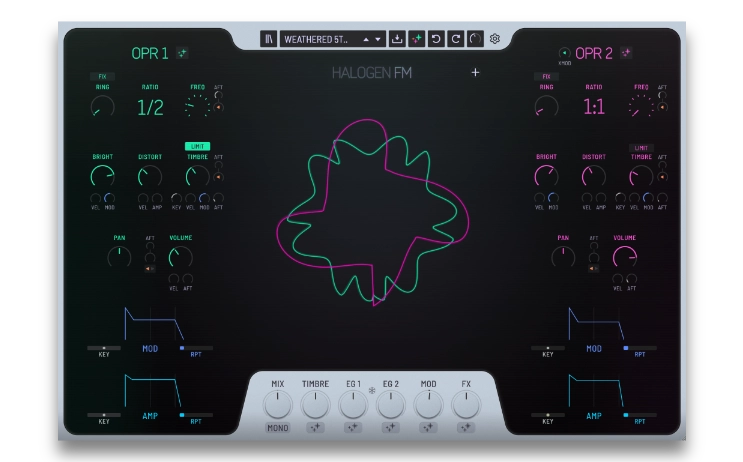August 12, 2025
by GForce Software
By sound designer Reverb Machine.
In this article, I’m going to look at Halogen FM and how to create three versatile sounds. Halogen FM makes FM synth patching nice and easy, so I’ll skip the deep theory and focus on making good sounds. Try following along, and download the presets at the end to compare your results.
Electric Piano
The most famous FM sound is the Yamaha DX7 factory electric piano. A common approach to electric piano sounds is to layer two parts:
- A sustained body for the main tone and
- A short, bell-like attack for the percussive ‘click’.
To recreate this in Halogen, use its two layers to build the body and bell elements. We’ll use the left layer as the body, so start from the init patch and turn “Timbre”, which controls the amount of FM, down to about halfway to create a darker tone. To make the patch more expressive, add envelope movement and velocity sensitivity by fully increasing the small “Vel” and “Mod” knobs underneath the Timbre knob. Now the patch will respond to velocity, and the amount of FM will decrease over time as longer chords are held, depending on the Mod envelope settings.

For the second layer on the right, increase the “Freq” knob by two notches to raise the pitch by 19 semitones. Set Timbre down to 0, and Bright to full to create a bright but simple tone. Finally, we need a short envelope, so lower the third stage (sustain) in the Amp envelope to zero and slightly shorten the second stage (decay). When you play the patch, you should hear a bright, percussive attack followed by a darker, sustained body.

From here, we can shape it further with a few tweaks. First, add some modulation from the LFO by using the small orange knobs next to certain controls; add it to the Freq for vibrato, to the Pan control for autopan or the volume for tremolo.

Another detail to enhance realism is how note length varies across the keyboard: on real pianos, lower notes ring out longer than higher ones. Emulating this effect in Halogen FM is very easy, and it’s done by setting the Key slider under the envelope. In the default middle position, envelope times are the same over the entire keyboard. Move it to the left to make lower notes longer and higher notes shorter.

Sawtooth Waves
Although FM is often used to emulate real instruments, it can also approximate analog synth sounds by creating sawtooth waves and applying detune. In Halogen FM, set the Timbre knob to 0 and the Distort knob to around 66–75% to create a basic sawtooth wave. This can be used as the foundation for synth keys, leads, and bass patches.

If you use sawtooth sounds in both Halogen layers, the identical waveforms will cause phase cancellation, resulting in a thin sound. To get that thick analog sawtooth character, apply some detune between the layers.
Halogen FM doesn’t offer direct oscillator fine-tuning, but we can be creative and get detune from modulation. Raising the small orange control next to the “Freq” knob will add LFO vibrato. By adding vibrato to one layer but not the other, we’ll get ensemble-style chorusing.

We can also get some detune using ring modulation. By raising both the “Ring” and “Timbre” knobs we’ll get some unusual, uneven pitch and waveform modulation. Keep the ring modulation amount under halfway, as high levels will produce more extreme sounds.
Combining both of these types of modulation, one in each layer, is a great way to get a lush, detuned sound. You can also add stereo width by panning the two layers left and right to create a wide, modern synth sound.

Arpeggiator-Style
Halogen FM doesn’t include an onboard arpeggiator, but you can create arpeggiator-style effects using the envelope repeat function. The “Rpt” slider under each envelope sets how many times the envelope repeats. At low values, it behaves like a complex multi-stage envelope. At high values, it functions more like an LFO.
To try this, start from the Init patch. Turn Timbre down to around 10 o’clock and raise its Mod modifier to maximum. Then shape the Mod envelope with no attack, a very short decay, and no sustain. Set “Rpt” all the way to the right and you’ll get a repeating sawtooth-style modulation.

Remember in the Electric Piano patch when we used the “Key” slider to make low notes longer and high notes shorter? If you apply that same slider to a repeating envelope, the loop speed will vary across the keyboard. When you play a chord spread over an octave or more, you’ll start to hear interesting rhythmic shifts as the voices fall out of sync. With the right envelope timing, this can begin to resemble complex arpeggiator patterns.

Of course, since Halogen FM has two layers, we can apply this technique to both layers for even more complexity. If the envelope timing between Layer 1 and Layer 2 is slightly different, the resulting rhythms will drift and shift against each other, creating more variation and movement. In my patch, I’ve also raised the Frequency of Layer 2 by an octave to add some high end.
You can take this idea further in lots of ways: try panning the layers apart for stereo motion, using different Timbre settings or octaves between the layers, and experimenting with the envelope shape and key scaling. A slower attack gives a softer sound, while a fast attack makes things feel more percussive. One layer can also be static, without repeat, to add a contrasting texture or anchor.
Download the presets

